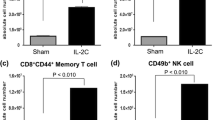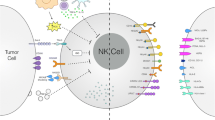Abstract
Recent studies have shown that cytokine treatment of tumor cells alters the sensitivity of these cells to lymphokine-activated killer (LAK) cells, depending on the cell line. In this study, we analyzed the decrease in LAK sensitivity of a human renal-cell carcinoma cell line (SMKT-R-3). The LAK sensitivity of SMKT-R-3 was decreased by treatment with a combination of interferon γ (IFNγ) and tumor necrosis factor (TNF). However, the cytokine treatment increased the expression of intercellular adhesion molecule-1 (ICAM-1) on the renal-cell carcinoma cell surface. The conjugate-formation assay also confirmed a slight increase in the binding rate of LAK cells to the renal-cell carcinoma cells. When actinomycin D (a protein synthesis inhibitor) was added to the culture medium prior to treatment with IFNγ and TNF, the LAK sensitivity of SMKT-R-3 recovered to the level demonstrated by the cells that had not received any cytokine treatment. These results suggest that the effect of cytokines in reducing LAK sensitivity of SMKT-R-3 is mediated by protein synthesis occurring when LAK cells are bound to SMKT-R-3 cells.
Similar content being viewed by others
References
Darzinkiewicz Z, Carter SP, Old LJ (1986) Effects of recombinant tumor necrosis factor on HL-60 cells: cell cycle specificity and synergism with actinomycin D. J Cell Physiol 130: 328
De Fries RU, Golub SH (1988) Characteristics and mechanism of IFN-γ-induced protection of human tumor cells from lysis by lymphokine-activated killer cells. J Immunol 140: 3686
Dustin ML, Rothlein R, Bhan AK, Dinarello CA, Springer TA (1986) Induction by IL 1 and interferon-γ: tissue distribution, biochemistry, and function of a natural adherence molecule (ICAM-1). J Immunol 137: 245
Fisher RI, Coltman CA Jr, Doroshow JH, Rayner AA, Hawkins MJ, Mier JW, Wiernik P, McMannis JD, Weiss GR, Margolin KA, Gemlo BT, Hoth DF, Parkinson DR, Paietta E (1988) Metastatic renal cancer treated with interleukin 2 and lymphokine-activated killer cells: a phase 11 clinical trial. Ann Int Med 108: 518
Flyer DC, SJ Burakoff, Faller DV (1985) Retrovirus-induced changes in major histocompatibility complex antigen expression influence susceptibility to lysis by cytotoxic T lymphocytes. J Immunol 135: 2287
Grönberg A, Ferm M, Tsai L, Kiessling R (1989) Interferon is able to reduce tumor cell susceptibility to human lymphokine-activated killer (LAK) cells. Cell Immunol 118: 10
Henkart PA (1985) Mechanism of lymphocyte-mediated cytotoxicity. Annu Rev Immunol 3: 31
Hojo H (1977) Establishment of cultured cell lines of human stomach cancer. Origin and their morphological characteristics. Niigata Igakukai Zassi 91: 737
Imai K, Ah-Kau NG, Glassay MC, Ferrone S (1981) Differential effect of interferon on the expression of tumor associated antigens and histocompatibility antigens on human melanoma cells. Relation to susceptibility to immune lysis mediated by monoclonal antibodies. J Immunol 127: 505
Kärre K, Ljunggren HG, Piontek G, Kiessling R (1986) Selective rejection of H-2-deficient lymphoma variants suggests alternative immune defense strategy. Nature 319: 675
Liu C-C, Detmers, PA, Jiang S, Young J D-E (1989) Identification and characterization of a membrane-bound cytotoxin of murine cytolytic lymphocytes that is related to tumor necrosis factor/cachectin. Proc Natl Acad Sci USA 86: 3286
Miyao N, Tsukamoto T, Kumanoto Y (1989) Establishment of three human renal-cell carcinoma cell lines (SMKT-R-1, SMKTR-2, SMKT-R-3) and their characters. Urol Res 17: 317
Miyatake S, Kikuchi H, Oda Y, Nishioka T, Takahashi J, Kondoh S, Matsumoto M, Yamasaki T, Iwasaki K, Aoki T, Kasakura S and Namba Y (1990) Decreased susceptibility of lined human gliosarcoma cells to lymphokine-activated killer cell cytolysis by γ-interferon treatment. Cancer Res 50: 596
Naganuma H, Kiessling R, Patarroyo M, Hansson M, Handgretinger R, Grönberg A (1991) Increased susceptibility of IFN-γ-treated neuroblastoma cells to lysis by lymphokine-activated killer cells. Participation of ICAM-1 induction on targets cells. Int J Cancer 47: 527
Nishimura T, Yagi H, Yagita H, Uchiyama Y, Hashimoto Y (1985) Lymphokine-activated cell-associated antigen involved in broadreactive killer cell-mediated cytotoxicity. Cell Immunol 94: 122
Owen-Schaub LB, Gutterman JU, Grimm EA (1988) Synergy of tumor necrosis factor and interleukin 2 in the activation of human cytotoxic lymphocytes: effect of tumor necrosis factor α and interleukin 2 in the generation of human lymphokine-activated killer cell cytotoxicity. Cancer Res 48: 788
Rosenberg SA, Lotze MT, Muul LM, Chang AF, Avis FP, Leitman S, Marston W, Robertson CN, Lee RE, Rubin JI, Seipp CA, Simpson CG, White DE (1987) A progress report on the treatment of 157 patients with advanced cancer using lymphokine-activated killer cells and interleukin-2 or high-dose interleukin-2 alone. N Engl J Med 316: 889
Russell JH, Dobos CB (1980) Mechanism of immune lysis. II. CTL-induced nuclear disintegration of the target begins within minutes of cell contact. J Immunol 125: 1256
Sone S, Utsugi T, Nii A, Ogura T (1988) Differential effects of recombinant interferons α, β and γ on induction of human lynphokine (IL-2)-activated killer activity. J Natl Cancer Inst 80: 425
Stewart WE (1981) The interferon system. 2nd edn. Springer, Berlin Heidelberg New York, p 7
Stötter H, Wiebke EA, Tomita S, Belldegrun A, Topalian S, Rosenberg SA, Lotze MT (1989) Cytokines alter target cell susceptibility to lysis. II. Evaluation of tumor infiltrating lymphocytes. J Immunol 142: 1767
Taniguchi K, Petersson M, Hoglung P, Kissering R, Klein G, Karre K (1987) IFN-gamma induces lung colonization by intravenously inoculated B-16 melanoma cells in parallel with enhanced expression of class I major histocompatibility complex antigens. Proc Natl Acad Sci USA 84: 3405
Taylor-Papadimitriou J (1980) Effect of IFN on cell growth and function. Interferon 2: 13
Tokuda Y, Ebina N, Golub SH (1989) The inhibitory effect of human interferon α on the generation of lymphokine-activated killer activity. Cancer Immunol Immunother 30: 205
Toledano M, Mathiot C, Michon J, Andreu G, Lando D, Brandely M, Fridman WH (1989) Interferon-γ (IFN-γ) and interleukin-2 in the generation of lymphokine-activated killer cell cytotoxicity-IFN-γ-induced suppressive activity. Cancer Immunol Immunother 30: 57
Uchida A, Klein E (1985) Natural cytotoxicity of human blood monocytes and natural killer cells and their cytotoxic factors: discriminating effects of actinomycin D. Int J Cancer 35: 691
Van Haelst-Pisani CM, Pisani RJ, Kovach JS (1989) Cancer immunotherapy: current status of treatment with interleukin 2 and lymphokine-activated killer cells. Mayo Clin Proc 64: 451
Weber JS, Jay G, Tanaka K, Rosenberg SA (1987) Immunotherapy of a murine tumor with interleukin-2. Increased sensitivity after MHC class 1 gene transfection. J Exp Med 166: 1716
Löms Ziegler-Heitbrock HW, Riethmüller G (1984) A rapid assay for cytotoxicity of unstimulated human monocytes. J Natl Cancer Inst 72: 23
Zöller M, Strubel A, Hämmerling G, Andringhetto G, Raz A, Ben-Ze'ev A (1988) Interferon-gamma treatment of B16 melanoma cells: opposing effects for non-adaptive and adaptive immune defense and its reflection by metastatic spread. Int J Cancer 41: 256
Author information
Authors and Affiliations
Rights and permissions
About this article
Cite this article
Yanase, M., Tsukamoto, T., Kumamoto, Y. et al. Decrease in lymphokine-activated killer sensitivity of a human renal-cell carcinoma cell line after cytokine treatment. Cancer Immunol Immunother 39, 22–26 (1994). https://doi.org/10.1007/BF01517176
Received:
Accepted:
Issue Date:
DOI: https://doi.org/10.1007/BF01517176




